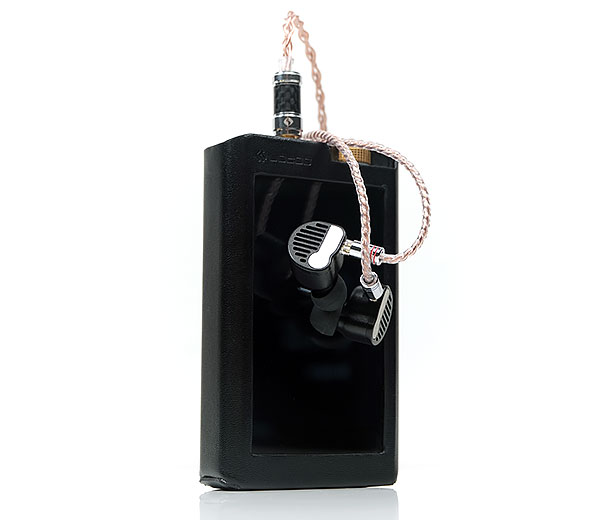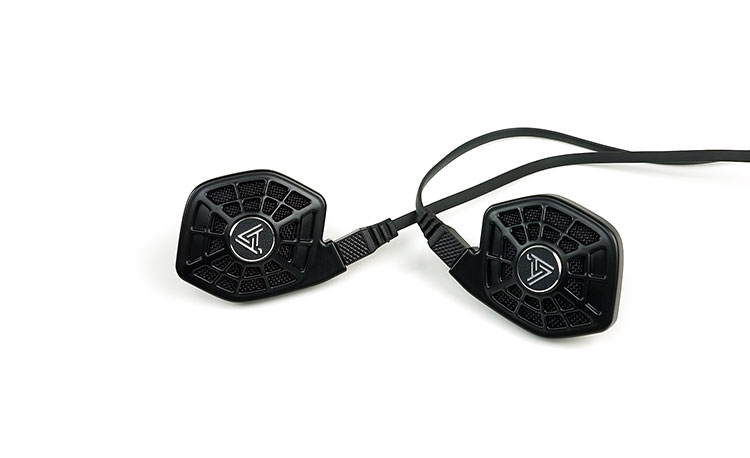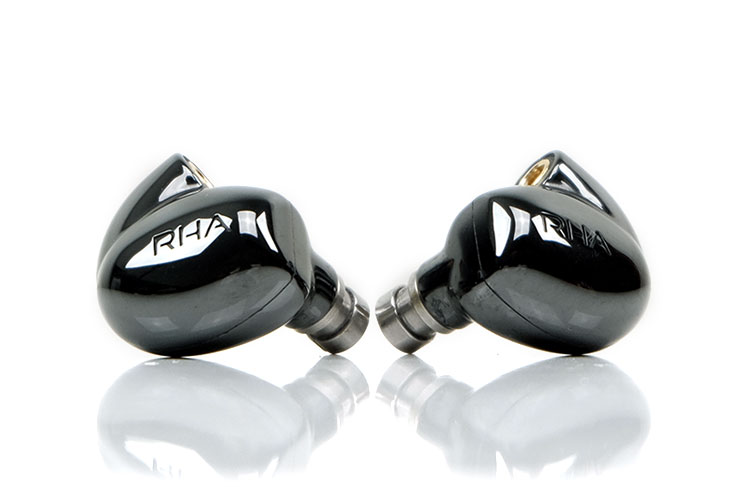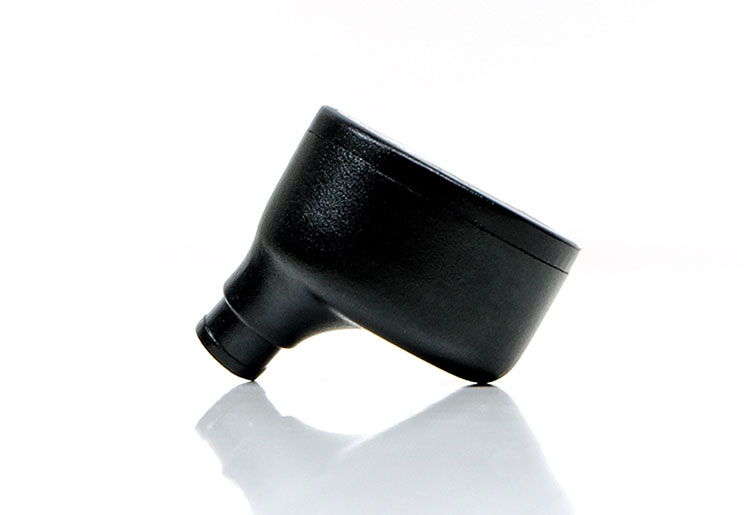Sound Impressions
Summary
The Nightingale is a dense-sounding rich and slightly mid-centric presentation. Not that the low-end does not have weight or body, far from it, rather it is a rising FR into the mids with a peak around 1-2k for a slightly forward vocal position.
The timbre is warm and relatively euphonic right throughout. The top-end is relatively relaxed though not tapered off so whilst I find it generally coherent it does lack a little headroom making the signature a slightly darker tuning with more of an emphasis on the lower mids to mids.
In some ways, the general FR does remind me of the original LCD-2‘s first production tuning before Audeze went all Fazor and more neutral. Instruments that saddle that rising lower-mid warmth and presence sound physical, dense, and with excellent texture.
It is the kind of sound signature that jives well with that “Les Paul” guitar sound as I like to call it. The Les Paul was (and still is) the stock in trade for that sleazy glam rock sound of the late ’80s, aka Slash most notably from Guns ‘N’ Roses.
That dual humbucker pickup-induced long sustain-driven tone is full-sounding, smooth and to die for when paired with blues, southern rock, and anything really that has a bit of medium-paced swagger to it.
This is not the fastest driver in the world though so if you prefer shredding, finger-tapping style music you might find a bit of smear on the Nightingale. It doesn’t really ‘turn on a dime’ as well as balanced armature drivers so this is more about body and physicality in a sense.
Staging
The Nightingale is more mid-centric than anything else but it does have decent depth and definitely that “planar sound” right down to the sub-bass response.
It is not as elevated as the ME.1 from Unique Melody but it is warmer and more full-bodied through the mid-bass so it doesn’t lack authority. If you are coming from the iSINE series I do think the Nightingale staging depth is a bit more convincing.
The upwards mid-bass to lower-mids curve places lower pitching instruments to the fore a little along with vocal positioning. Not as in your face as the iSINE 10 or the CL2 from RHA but it is a more intimate experience than neutral.
The lack of treble extension and energy does rob the Nightingale of a little headroom and pushes your attention back down the curve a bit.
Imaging is good, however, and the Nightingale does well with the space it affords to the listener, especially with a source or amp with decent power such as the Lotoo PAW Gold or the old but still awesome current-mode Bakoon HPA-01M.
Bass
The low-end on the Nightingale is weighted more on an upward curve with plenty of body and a rich warm overtone. Sub-bass presence is more on the neutral side with a rising response from 100Hz right up to 1K so mid-bass elevation and upper-bass warmth seep into the drum and guitar timbre.
If you need something tighter, something pacier the Nightingale will not be your choice here. I recommend going with a dynamic driver or multi-BA to get something punchier and cleaner.
You can call this tuning analog, maybe organic as it does remind me of a rich tube amp overtone with that languid pace, dense sustain, and a long decay.
I do love this type of tuning with my classic rock and ‘nu-school’ hard rock. The type of dirty biker stuff they only seem to make in Scandinavia these days unless Coverdale pops up with another Whitesnake live album.
It sounds especially juicy with Beach and Aldrich’s 2004 live rendition of “Still Of The Night” by the way, perhaps one of the best live recordings of that song out there.
Mids
Chances are high this is where your ears are going to be drawn to the most with the Nightingale tuning. From 500HZ to 1K the FR on the Nightingale is on the rise with a medium elevation from 1-2k and a gentle but noticeable drop from 2-4/5k typical of some planar headphone tuning.
If you are coming from the RHA CL2 it is almost the complete opposite save from that 1-2k rise. I would not call this a neutral positioning though. I still find vocals slightly to the fore.
Rather, the lower-mids are not that dipped or scooped out so they have plenty of presence and sit close to vocals in terms of positioning, particularly male vocals.
Female vocals that push past 2k (really high pitching) are positioned a little further back but still sound very smooth and rich with very little sibilance.
The instrumental timbre is smooth, rich, and euphonic with plenty of even-harmonic bias. That will swing a lot of people’s preferences. If you prefer clean, pristine note articulation with a fast decay and tons of separation this is not it.
I advise the Custom Art FIBAE 7 if you want some warmth and still plenty of separation. What the Nightingale gives you is that classic analog tube-type timbre, even with neutral sources.
Treble
The Nightingale 2-4k dip and moderate 5-7k rise means you get a wet, dense percussion timbre with plenty of even-harmonic overtones. Percussion is not terribly forward but it is plenty solid, just lacking in a little odd-harmonic contrast for snap and bite.
I like my treble with plenty of body, but I also like it with a touch more crispness just to add some presence to the top end of a note.
That is perhaps the Nightingale’s Achilles heel though a correctable one. It is a very forgiving treble and overall I find it quite coherent with the rest of the sound signature of the Nightingale.
Certainly, more balanced sounding than Unique Melody’s ME.1 upper mids to treble tuning. However, if you want more bite along with that body you are going to have to EQ or PMEQ by a few dB from around 3-5k and 8-10k.
Synergy
Efficiency
The Nightingale is rated at 26Ω and 105 dB SPL so not the highest load but the SPL is a little deceiving as you will find that it does require significant current from even powerful DAPs such as the Lotoo PAW Gold Touch and the Cayin N6ii, both of which can deliver up to 0.5W output power.
I do wonder if AAW should ideally equip the Nightingale with a 2.5mm or 4.4mm version of their excellent Tiburon stock cable just to drive that message home that a moderate DAP or smartphone will not cut it.
For example, my Samsung Note 9 volume was at 100% and it fell just shy of my usual listening levels. Not by a huge amount but it was short of some headroom for sure.
The good news is that the open-back design combined with the relatively inefficient SPL means that high noise floors in all amp stages are not an issue with the Nightingale.
You simply will not hear any background hiss on any DAP out there and a few portable amps also such as the ALO Audio V5 and the Oriolus BA300S.
Power
I have to admit the Nightingale sounds far more competent with the more power you throw at it. This is a scalable monitor with a lot of potential.
Current mode amps such as the Bakoon HPA-01M are excellent with the Nightingale. This is a neutral, fast, and tight amplifier, quite different from the dreamier tube sound of the ALO Audio V5 which is too soft sounding for me with the Nightingale.
The immediate difference I noticed with this pairing (PAW Gold Touch as the sourced), was the enhanced low-end to mids separation and a much more open midrange.
You get far better staging width and a bit more headroom also. DAPs are good, some better than others but a dedicated portable amp with power or something almost desktop-level will take it to the next level.
DAPs
If you don’t fancy stacking or going desktop then I advise a fairly neutral DAP with good output levels or a very clean treble tuning.
I actually quite liked it going balanced with the FiiO M11. Not that the M11 is blessed with huge power, rather it is a clean sound without too much bass low-end which seemed to produce a fairly smooth bloat-free response on the Nightingale.
I do advise going balanced if you can which may require a different cable termination on the Tiburon such as 4.4mm.
If you want good output power unbalanced then the iBasso DX220 with AMP1 MKII and the flagship Lotoo PAW Gold Touch have the chops to deliver superior separation with the Lotoo, in particular, excelling at the level of dynamic range it can deliver with the Nightingale.
Select Comparisons
Audeze iSINE 10
$399
Technical
My apologies, Mike did the LCD-i3 and iSINE 20 reviews and those two might have been better matches. Here, in the main office, we have the iSINE 10 so that is our comparison model this time.
Whilst the premise is the same, an open-back full-range planar in-ear universal monitor, the execution and design of these two could not be more different.
The iSINE 10 uses a full-range 30mm planar driver with Fluxor magnet technology and a patented Uniforce voice coil. That is a bit bigger than the Nightingale’s 15mm MPMTM micro planar magnetic driver with a PVD deposited voice coil planar diaphragm.
Physical
Twice the size of drivers in fact and physically the iSINE 10 is about twice the size of the Nightingale also though quite light at 20g.
The design of the Nightingale is a much more traditional monitor in form fact, the iSINE 10 is incredibly unique, large, and works more like a set of mini headphones with the majority of the driver outside your ear and just the nozzle coming inside your ear.
The iSINE 10 is much less comfortable as a result. You do need ear hooks to keep it safely in place whereas the Nightingale is snug, comfy and seals a lot better.
Now all iSINE and the LCDi4 work on the same basis so this is not a price gap thing for Audeze in-ear planars. I don’t find the iSINE 10 uncomfortable myself but contextually the Nightingale smiles ahead. It also feels sturdier than the plasticky iSINE 10.
Cable
The stock analog cable on the iSINE 10 is a bit meh. It’s black, 1.5m in length and fairly flat rather than rounded or braided as most traditional IEM cables are. It is no match for the Null Audio Symphonym Tiburon UPOCC Copper Cable on the Nightingale.
However, most will say the Cipher cable that works with iOS and has an internal DSP/amplification stage is much better than the stock and this is true if you happen to use an iOS ecosystem. Otherwise, if no iOS get a better non-memory wired alternative.
Performance
The iSINE 10 is rated at 16Ω and 120dB SPL compared to the Nightingale’s 26Ω and 105dB SPL. It is much less demanding and more efficient than the Nightingale with at least an 8-10 step increase required in high gain 3.5mm TRS on the Lotoo PAW Gold Touch and similar levels on the Cayin N6ii unbalanced.
Neither will show up any hiss on higher noise floor DAPs such as the FiiO M11 but I do prefer both of them in high gain rather than low if you stick to unbalance, (stock cables).
Tuning
The iSINE 10 is a little more neutral and brighter in its treble performance compared to the darker and fuller-sounding Nightingale. The low-end on the iSINE 10 lacks a little body and may be amplified by up to 4-5dB less compared to the Nightingale’s bass tuning.
Not that the Nightingale is bass dominant but it does have more presence and a little more warmth up into the lower-mids compared to the iSINE 10.
Mids on both are raised and forward sounding. In fact, the iSINE 10 has an FR that rises a little earlier and amplifies a bit more than the Nightingale.
However, because of the neutral low-end, the instrumental timbre on the iSINE 10 is not as warm and rich sounding. Both have a forward vocal presence but more so on the iSINE 10 but they can be a bit more sibilant than the euphonic Nightingale vocal timbre.
You could argue the iSINE timbre is more neutral but I would say it can be a bit hard sounding because of its treble tuning being much more aggressive around 7-10k.
The Nightingale is softer, wetter, and smoother sounding. True enough, it lacks a bit of air and sparkle compared to the iSINE 10’s energetic top-end but it does fatigue a little less.
RHA CL2
$899
Technical
Perhaps more than any recent release the CL2 comes closest to the Nightingale as a competitor on paper. The price point is just marginally lower than the nightingale as well and inside you do get an additional cable (balanced silver) and a wireless aptX capable alternative.
Inside, the size of the two planar IEM drivers is not that different either. The CL2 uses a planar coil and 16-micrometer diaphragm suspended above two matched magnetic fields. Literally, the diaphragm is suspended in mid-air.
The Nightingale is just marginally smaller with that 15mm MPMTM micro planar magnetic driver but uses a PVD-deposited voice coil planar diaphragm.
The big design difference, however, is that the CL2 is a closed-back planar design and the Nightingale is an open-back. This will change the tonal characteristic somewhat but also means the CL2 will isolate much better.
The CL2 also uses an MMCX system compared to the 0.78mm 2-pin of the Nightingale. I find the MMCX of the CL2 a little more awkward to use due to the short stem and smooth housing making it difficult to grip when connecting.
Performance
The RHA CL2 is rated at 15Ω and a massively inefficient 89dB SPL. Despite that, a side-by-side testing of the Nightingale and the CL2 did not reveal any massive volume difference using high gain on the Cayin N6ii which surprised me.
The same pattern pretty much played itself out on the FiiO M11 and the Lotoo PAW Gold Touch so perhaps a little bit of the lower impedance value and the better isolation of the CL2 is a factor here.
Noise on both is non-existent with all DAPs tested nor would you expect to find any with two monitors rated at 89dB and 105dB SPL.
Tuning
The CL2 is much more u-shaped and elevated on the sub-bass and upper mids compared to the Nightingale. It has a bit more treble/bass contrast also with a small peak around 8-10k.
From 20-100Hz there is more punch and power in the CL2 tuning but it drops quite rapidly into the lower mids so it is a little cooler in its timbre and not as rich and warm as the mid-bass to lower mids of the Nightingale.
Personally, I find the CL2 lower-mids messy, a little recessed, and lacking in separation for rock standards and anything requiring lower-mids instrumental clarity.
The Nightingale has the better instrumental presence and texture but can smear a little and is not quite as precise as a solid tuned balanced armature or dynamic driver response.
I would pick the Nightingale for rock standards over the CL2 for its richer timbre and better ‘Les Paul’ sleaze rock overtones in its lower mids. The CL2 seems to mate much better with modern EDM/R’n’B or pop with female vocals which sit more in that big upper mids rise past 1k.
The less work it has to do from 500Hz to 1k the better it sounds. If you are a Billie Eilish or Chainsmokers fan the CL2 is a lot of fun and more fitting of that classic closed-back punchy sound and intimate vocal tuning.
Treble on both is on the relaxed side but I find the Nightingale a bit more balanced whereas the CL2 forward upper mids tend to dominate a lot more and sounds less even or coherent. That little 8-10k peak does help to prevent the CL2 from sounding dark but it is very underplayed for me.
Unique Melody ME.1
$769
Technical
The ME1. is a bit long in the tooth having been released in 2017 and the price since then has dropped a little to around $600. I am not even sure UM is making it anymore but I have seen a few for sale recently.
This was the first real in-ear planar design for me with the additional bonus of a quasi-pressure relief system, (acoustic filtering) to protect your hearing.
The ME1. uses a marginally larger 18mm dual-layer high-strength neodymium magnet driver tucked inside an open back designed 3D printed medical-grade acrylic mold. This is a larger monitor compared to the Nightingale but the acrylic design makes it a lighter one.
The ME1. uses a bit more of a custom universal design than the Nightingale but given the diminutive size of the AAW design, the comfort levels are not that much different. The ME.1 needs enhanced contouring to allow the larger size to fit comfortably whereas the Nightingale’s smaller form factor slots right in and looks very flush to the ear.
Both use a 0.78mm 2-pin connection system, however, the ME.1 uses UM’s protruding stem and sheath connector system. Not a proprietary system, you can use aftermarket cables but the stem length makes it weak for regular 2-pin cable connections.
Performance
The ME.1 is rated at 23.1 ohms and 109dB compared to the Nightingale’s 26Ω and 105dB SPL. Neither have particularly high load ratings but they are not the most efficient and do need a bit more current than the average IEM.
The 4dB SPL doesn’t seem much on paper but in actual fact, there is a bit of a gap for volume between these two using a high gain 3.5mm TRS setting on the Lotoo PAW Gold Touch. I would put it around 8-10 steps on the volume higher than the ME.1 for rough volume matching.
Neither have issues with noise from higher noise floor amp stages so they both are dead quiet with black background on the likes of the FiiO M11 and the Cayin N6ii with the A01 motherboard. I did find that both sounded a little “juicer” with better volume control on high gain compared to low gain on all 3 tested DAPs.
Tuning
The ME.1 has a gentle u-shaped signature with a little uptick in the lower treble response around 4-6k for additional contrast. I would say the low-end from sub-to mid-bass is more emphasized than the Nightingale and the cut into the lower-mids is a bit more dramatic.
That means it is fairly powerful sounding with plenty of rumble in comparison to the warmer thick mid-bass of the Nightingale. The ME.1 is a little lighter on instrumental timbre and its mids positioning is a little recessed up to 1K compared to the Nightingale’s more forward sounding mids.
Higher-pitched vocals on the ME.1 are not as dipped but still not as close sounding as the Nightingale. I personally feel I can connect better to a singer with the Nightingale mids tuning.
The ME.1 soundstage is deep and relatively tall but it dips the mids to try and create a perception of space. They can sound a little distant for me compared to the more vocal forward and intimate Nightingale midrange tuning.
The ME.1 has a slightly uneven treble response with a fair old peak around 6-7k then it fades away with a slight nudge around 10k. It doesn’t seem to add any excitement or headroom to the ME.1 tuning.
Despite the Nightingale being a little more relaxed and perhaps the darker of the two I find the treble tuning to be more coherent and balanced sounding.
Our Verdict
The Nightingale adds its own unique almost tube-like sound to a growing range of planar magnetic driver monitors out there. Just which one you prefer will come down to your preference, both in terms of the music you like to hear and how you like it to be heard.
For those who found the iSINE bass weight perhaps a tad too neutral or the ME.1’s overall tuning a bit unbalanced, the Nightingale is richer, warmer, and more coherently tuned.
It does lack a touch of air and separation but the more power you throw at it the better it gets. A good portable amp or even a desktop will stretch the staging and add some more welcome headroom.
Once sorted, I find the Nightingale a little “doozy” of a universal monitor for my classic hard rock where a rich slow “Les Paul” sound is absolutely required. If that’s your bag then the Nightingale will slot in quite nicely.
AAW Nightingale Specifications
- 15mm Planar Magnetic Driver
- Single Sound Bore Design
- Frequency Range: 5-60000kHz
- Nominal Impedance: 26Ω
- Sensitivity (SPL): 105 dB@1kHz







